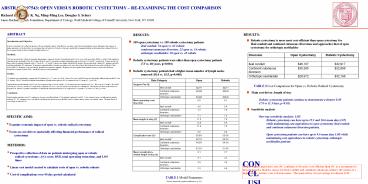ABSTRACT 97543: OPEN VERSUS ROBOTIC CYSTECTOMY - PowerPoint PPT Presentation
1 / 1
Title:
ABSTRACT 97543: OPEN VERSUS ROBOTIC CYSTECTOMY
Description:
ABSTRACT 97543: OPEN VERSUS ROBOTIC CYSTECTOMY RE-EXAMINING THE COST COMPARISON ... of Anesthesiologists (ASA) score, body mass index (BMI), as well as total ... – PowerPoint PPT presentation
Number of Views:84
Avg rating:3.0/5.0
Title: ABSTRACT 97543: OPEN VERSUS ROBOTIC CYSTECTOMY
1
ABSTRACT 97543 OPEN VERSUS ROBOTIC CYSTECTOMY
RE-EXAMINING THE COST COMPARISON
Richard Lee, Casey K. Ng, Ming-Ming Lee, Douglas
S. Scherr James Buchanan Brady Foundation,
Department of Urology, Weill Medical College of
Cornell University, New York, NY 10021
ABSTRACT
RESULTS 109 open cystectomy vs. 105 robotic
cystectomy patients ileal conduit 54 open vs.
63 robotic continent cutaneous diversion 25
open vs. 14 robotic orthotopic neobladder 30
open vs. 45 robotic Robotic cystectomy patients
were older than open cystectomy patients (73 vs.
68 years, p0.001) Robotic cystectomy patients
had a higher mean number of lymph nodes removed
(18.4 vs. 15.5, p0.048)
RESULTS
Introduction and Objective Robotic cystectomy
(RC) offers the promise of lower morbidity
surgery with effective oncologic control for
treating bladder cancer, although at the expense
of higher materials cost. In this study, we
re-examine the cost behavior of robotic
cystectomy, specifically examining whether such
treatment has continued to lower the economic
burden of disease despite its higher initial
cost. Methods Data was prospectively collected
on patient demographics, American Society of
Anesthesiologists (ASA) score, body mass index
(BMI), as well as total anesthesia, operating
room, and length of stay (LOS) times from 104 and
79 consecutive patients undergoing open
cystectomy (OC) and RC, respectively. A linear
model was then created to simulate treatment with
OC versus RC. OC and RC cohorts were further
subdivided by urinary diversion into ileal
conduit (IC), Indiana pouch (IP), and ileal
neobladder (IN) subgroups. To maximize
generalizability of results, procedural costs
were derived from the Medicare Resource-Based
Relative Value Scale (RBRVS). Materials costs
were directly queried from respective suppliers.
Hospital costs were queried from internal sources
as well as the Medicare Prospective Payment
System (PPS). Sensitivity analyses were
performed. Results OC patients were
significantly younger than RC patients (68 vs. 73
years, p0.001). Mean ASA scores, and BMI were
not statistically different between the RC and OC
cohorts. The RC cohort had a higher mean number
of lymph nodes removed (18.4) compared to the OC
group (15.5, p0.048). Despite the increased
materials cost, RC was less expensive than OC for
IC and IP. OC in contrast was less expensive for
ON. The costs of OC with IC, IP, and IN were
46,107 38,365 and 29,972 respectively
compared to 32,917 32,898 and 32,198 for
their RC counterparts. The largest cost driver
in the study was hospital LOS, where RC patients
continued to systematically demonstrate shorter
LOS compared to OC patients (7.8 versus 11.5
days, plt0.001). Conclusion Despite higher
materials costs, RC continues to be more cost
efficient than OC for patients requiring IC and
IP. OC in contrast is more cost efficient for
patients desiring ON. RC continues to be a
cost-effective treatment for muscle invasive
bladder cancer at a high volume, tertiary care
referral center. The main driver of cost savings
is reduced LOS.
Robotic cystectomy is more most cost-efficient
than open cystectomy for Ileal conduit and
continent cutaneous diversions and approaches
that of open cystectomy for orthotopic neobladder
Figure 1
TABLE 2 Cost Comparison for Open vs. Robotic
Radical Cystectomy
2 to 3 cm away from the vasectomy site
Main cost driver length of stay Robotic
cystectomy patients continue to demonstrate a
shorter LOS (7.8 vs 11.5 days, plt0.01)
Sensitivity analysis One-way sensitivity
analysis LOS Robotic cystectomy can have up to
15.1 and 10.6 mean days LOS while maintaining
cost equivalence to open cystectomy ileal
conduit and continent cutaneous diversion
patients. Open cystectomy patients can have up
to 9.6 mean days LOS while maintaining cost
equivalence to robotic cystectomy
orthotopic neobladder patients
- SPECIFIC AIMS
- Examine economic impact of open vs. robotic
radical cystectomy - Focus on cost drivers materially affecting
financial performance of radical - cystectomy
- METHODS
- Prospective collection of data on patients
undergoing open or robotic - radical cystectomy ASA score, BMI, total
operating room time, and LOS - times
- Linear cost model created to calculate costs of
open vs. robotic cohorts - Cost of complications over 90 day period
calculated
CONCLUSIONS
Despite higher materials costs, RC continues to
be more cost efficient than OC as a treatment for
muscle invasive bladder cancer for ileal conduit
and continent cutaneous urinary diversions at a
high volume, tertiary care referral center. The
main driver of cost savings is reduced LOS.
TABLE 1 Model Parameters
Denotes statistically significant differences,
plt0.05































